LOCAL CHARACTERS
William Henry Lindsey
WH
Lindsey was born 1906 he lived between Wadebridge and at times in Newquay. His father was a master
baker in Egloshayle Road Wadebridge. His grandfather and uncle were boat builders W.H. Brabyn of
Trevilling Quay. As a lad, he spent most of his time helping out with building and repairs to vessel
there, often taking his young daughter Mary with him. She would love to sit on the benches and watch
granddad at work. In 1921 he applied to his uncle Steve Brabyn of Padstow, to become an apprentice.
His Father took him down to Padstow to meet his new employer Steve. He got the job and started the
following day. Having to travel down from Wadebridge by train and walk to the yard which was known as
the lower yard.
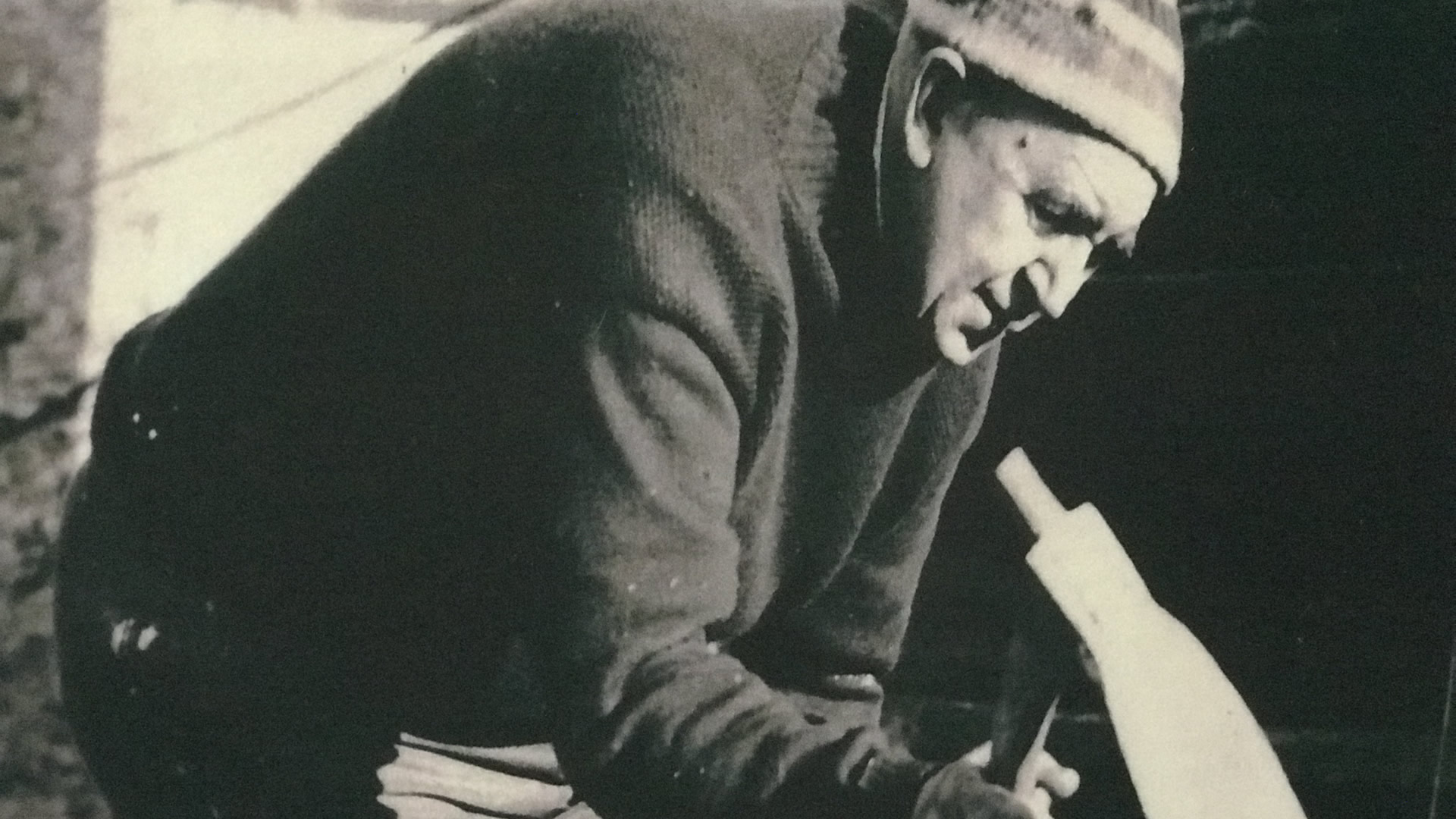
One of
his first jobs was cleaning up the shavings in the sheds where men had been working. His main first
job was with the “Helen Peele” she was the RNLI tug stationed at Padstow, she was to be brought in to
the dock on the next spring tide, before this could be done the base of the dock had to be cleared of
stones, rocks and bulks of timber, then chocks were laid for the boat to sit on.
All this work
was over seen by RNLI inspectors, the boat had to sit level and square to prevent any damage. On the
next spring tide she was brought in, Owing to her size it was a very difficult job.
Being an
apprentice, he was subject to all the mundane jobs which he carried out and soon became a
well-respected apprentice, there wasn’t a job he would not have a go at. All through his
apprenticeship he worked very hard and soon became head apprentice. He built his first dinghy which in
those days an apprentice had to do before becoming a trades man. During the war period he worked on
many navy related vessels. So he applied to go to Plymouth dockyard to work on vessels. But as many
became aware of Steve Brabyn did not give out Indentures. He carried on working with Steve Brabyn for
many years, before opening his own yard within the red brick building. The down stairs were okay and
one large room was made over to build boats and the one next door was mainly for repairs. Soon after
this he took over the running of, the Padstow to Rock ferry. Built his own boats, from his own
design. He built the “St Petroc” Percy Mitchell built another one called the “St Petrocstowe”, there
was also “St Minver”, “Aurivour” and of course the “Zim”. When things started to get busier, he built
the “St Saviours”, this was built in the Redbrick building, but was so big he extended the doors to
cover the protruding bow.
I am sure at this time He was the biggest employer in Padstow and by
now he had taken over another yard up at the old fish market.
Work was hard and money was
short, most of the main jobs now were the fishing fleets coming in from all over the country. Jobs
were repairs to trawl doors, bobbing any woodwork needed. From the early onset of starting on his
own, he took on all work such as clearing Rock beach of the miles and miles of barbed wire from the
war. The breaking up of the schooner “Genesta” was another job he took on. Selling mussels from
Porthilly to Poole in Dorset he worked on with Tom Morrissey.
With Brabyns
yard going into disrepair, he bought the yard from Steve, the work carried on from there, the redbrick
building and the station yard site. Another venture Father went into was the old ice factory, this
was one of his yards. He went into a company business and built a café, a dance hall and a shop which
my sister Barbara ran.
After many years, the coming of fibre glass came to Cornwall, wood
boatbuilding took a bad hit. From this he went sadly into a venture to build a Hotel on the lower
yard site, this was carried out by family and builders from Newquay and Padstow. The Padstow Boatel
was formed this combined a restaurant, hotel with many rooms a bar and lounge. 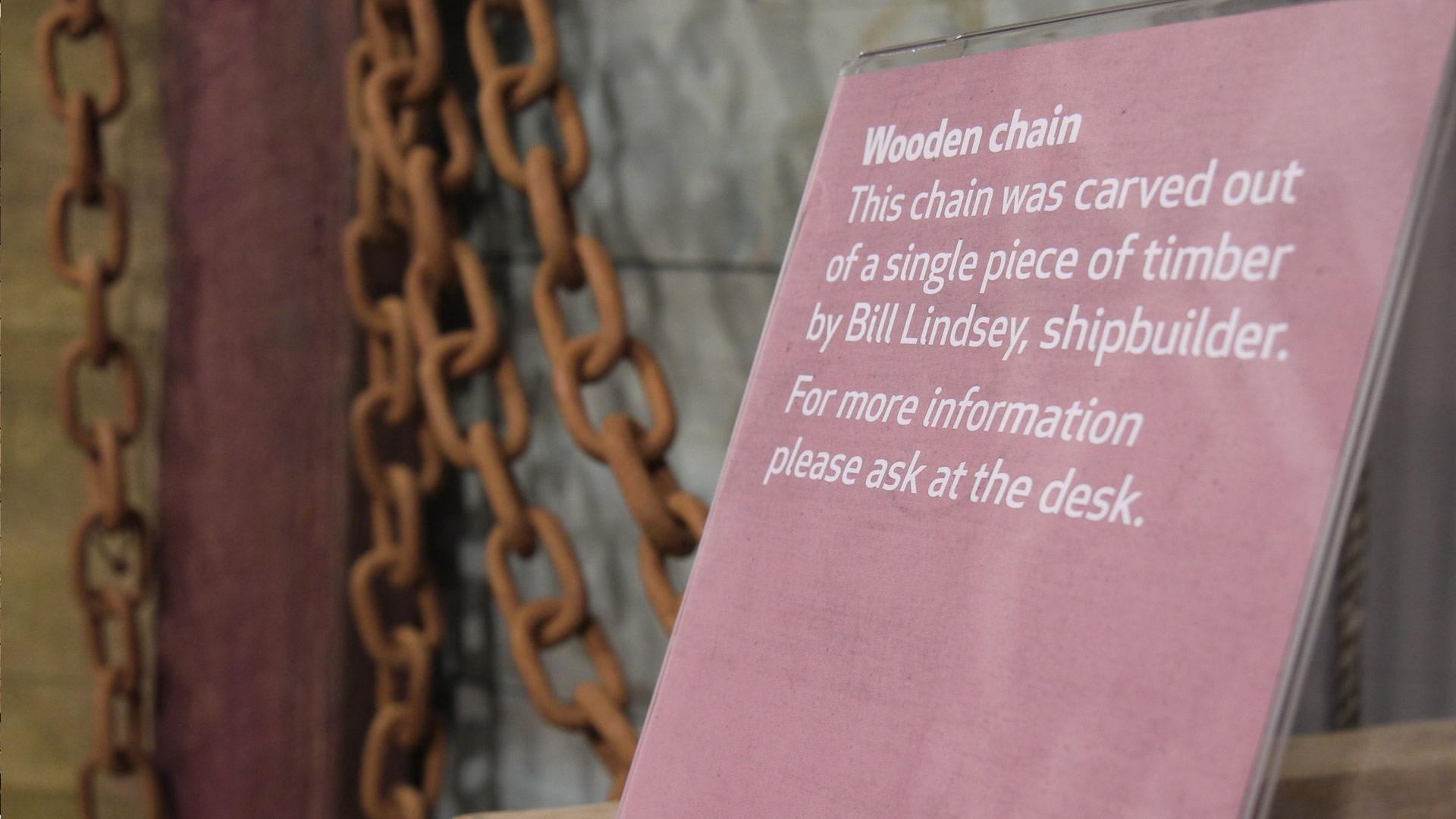
Father and mother ran this for a few years but sadly lost the business!!!
With the ending of his life’s work, he and members of the family, and several people from Padstow, he
decided to donate his tools and form a museum. This was started around 1972, his sons Bill and Derek
were there to assist him with this venture and Derek is still there some 46 years on.
We as a
family started a smaller venture and that is of the Padstow Craft club, we had several different
crafts going with Father tutoring some of the youngsters.
From there he came to live at
Porthcothan with his son Derek and from there worked at Tregirls car park where he took on a new hobby
of carving, the first project was love spoons he made them whilst taking money at the car park he
found people were asking to buy them, welsh dressers and furniture for dolls house were among the bits
he produced. It was around this time that Mother developed cancer.
To help with cancer funds,
he decided on his biggest venture of all “Wooden chains” This one is on display at Padstow Museum.
This was made from a piece of mahogany, I’m not sure exactly what type of mahogany, it’s dimension
was 2inch x 2inch and some 26 feet long, with this he made a wooden chain all by hand, and when
finished it had grown two feet in length.
This was displayed over in the White shelter and
people were asked to guess the length, with money going to the hospice towards a scanner, he displayed
his chain all over Padstow and raised a lot of money, sadly mother passed away but his work
fundraising for cancer carried on.
40 odd years later, Bill my father is still alive within the
walls of our wonderful Padstow Museum, you can see his chain there hanging in a corner with a draft of
what it was for.
I hope you enjoy my short account of my wonderful fathers’ life.
Derek Lindsey August 2019
______________________________________________
Tommy Morrissey
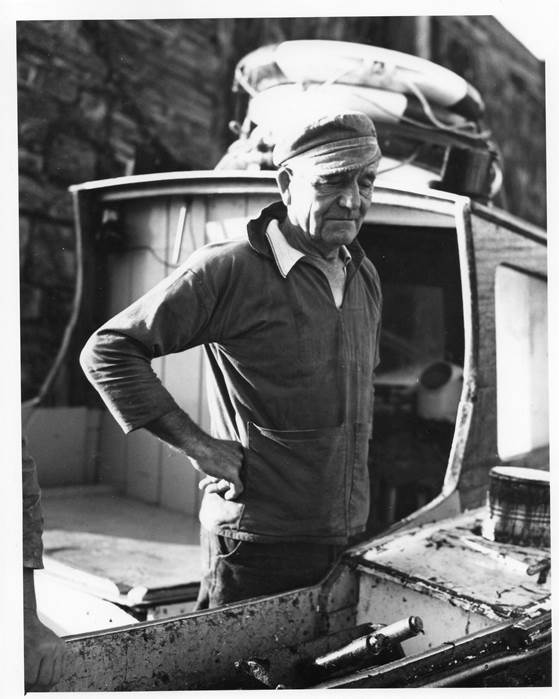 Born
Thomas Patrick Morrissey on 3rd December 1915 to Jimmy and Kate Morrissey. Both Jimmy's father
and Kate's father (Patrick O'Keefe) had left Ireland during the potato famine and settled in
Cornwall marrying Cornish girls. Jimmy and Kate lived at 12 South Quay looking out at the boats. Jimmy
at that time was a fisherman working under sail with the Kingfisher and taking summer visitors on
fishing trips. He also had a fleet of small boats which were hired to visitors for their own
adventures on the Camel. Tommy grew up in and around the boats and was helping Jimmy from a young age.
When Tommy was nine the elementary (board school he called it) encouraged him to enter a drawing
competition run by the British and dominions school of drawing. His entry was good enough for him to
be offered a reduced price correspondence course. They hoped to persuade the family for Tommy to take
up a scholarship course. There was not enough money but more importantly Jimmy being crippled in a
boating accident aged 11 was now relying on Tommy to help with the boats.
Born
Thomas Patrick Morrissey on 3rd December 1915 to Jimmy and Kate Morrissey. Both Jimmy's father
and Kate's father (Patrick O'Keefe) had left Ireland during the potato famine and settled in
Cornwall marrying Cornish girls. Jimmy and Kate lived at 12 South Quay looking out at the boats. Jimmy
at that time was a fisherman working under sail with the Kingfisher and taking summer visitors on
fishing trips. He also had a fleet of small boats which were hired to visitors for their own
adventures on the Camel. Tommy grew up in and around the boats and was helping Jimmy from a young age.
When Tommy was nine the elementary (board school he called it) encouraged him to enter a drawing
competition run by the British and dominions school of drawing. His entry was good enough for him to
be offered a reduced price correspondence course. They hoped to persuade the family for Tommy to take
up a scholarship course. There was not enough money but more importantly Jimmy being crippled in a
boating accident aged 11 was now relying on Tommy to help with the boats.
Tommy left school at
14 and started work on the fish market working as a ganger under Charlie Brinham but after two weeks
he was taken on by Bloomfields of Yarmouth. Their boats came to Padstow for the Trevose white fish
season from January to May each year. Tommy had many jobs with Bloomfields learning the ropes but was
employed by them each season ending up as their agent in Padstow responsible for re-provisioning the
trawlers, keeping a tally of their landings at the market sorting out repairs, coaling, water and ice
so that they could go back to sea after a couple of days in port.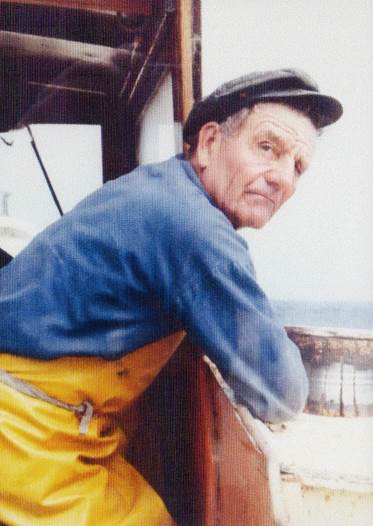
In the summer he helped on the Kingfisher with the trips for visitors,
catching mackerel. Bass and herring in season as well as coping with the hire of the small boats,
their maintenance and recovery when visitors got tired of rowing or scared of the sea and abandoned
them all up and down the river. There was always more than enough to do.
Then aged 21 he
developed peritonitis which put him in hospital in Bodmin, in a touch and go situation for a while.
During his recovery he was taught how to make and put ships in bottle by another patient, on his
discharge he had a very useful skill. The art of carving the ship's hull, the fine painting and
the intricate rigging and sails suited his artistic abilities but most of all he loved painting the
putty seas and the signal flags flown from the ships masts.
When he had recovered, he went back
to work on the "Kingfisher" with his Father. He was deemed not fit to be called up for war
service but went into coastal command and ended up as a Chief's� Petty Officer serving around
Cornwall and in Plymouth on search and rescue for downed planes and boats that had hit mines in the
western approaches.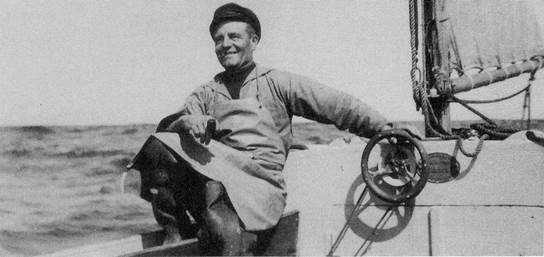
1945 saw him back in
Padstow running the Kingfisher married and with a baby daughter to support. Jimmy�s injury now had him
mostly bedridden and Tommy supported the whole family. Fishing was good the trawlers came back Tommy
was with Bloomfields again for the season and the train was bringing in visitors, He had a good side
line with his ships in bottles his painting skills were put to good use painting the registration
letters and numbers on other fishing boats .When he was 14 he had been co-opted by his Uncles to paint
the hat for the Blue Ribbon Obby Oss (Peace Oss) This job he continued to do for the whole of his
life. He also designed and painted the Blue Ribbon stable sign which is on the Harbour Inn next door
to Tommy's cottage in Strand Street.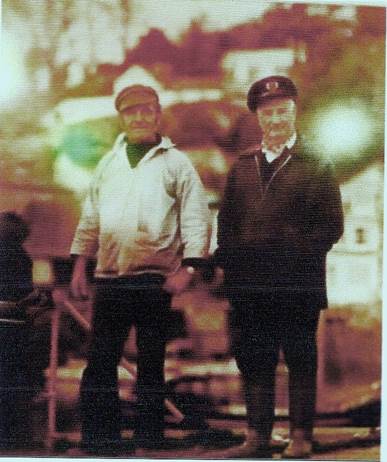
The family moved into the cottage in 1952 at the
same time he bought the ex-lifeboat "Docea Chapman" and converted her into the fishing boat
"Girl Maureen". A good sea boat and with his fishing skills a good earner for the family.
Tommy was always around the quay the Irish ancestry made him happy to stop and chat with one and all
passing on the history of the locality orally to anyone who had the time to listen. He would be on the
quay mending nets making pots fixing engines painting boats or their registration numbers and if he
was happy the fishing was good and the sun was shining he'd be singing. He had been on the radio
programme "Down Your Way" with Richard Dimbleby talking about ships in bottle and was sent
loads of Dimple bottles in the hope of a ship in return. His chosen song was "One of A Roving
Kind" so he sang that a lot, but he also favoured "The Yellow Rose of Texas" and
"Farewell and Adieu to you Spanish Ladies" and selections of songs that his Mother Kate sang
from time to time.
As daughter number one got married daughter number two arrived to help out
on the boats and keep him company down quay. In the early 1970's he made and painted the hat for
the Blue Ribbon and the Old Oss. Maureen had presented him with a Grand-daughter and for the baby he
made a rattle in the form of the teasers club for the Blue Ribbon Oss. He was still putting ships in
bottles for friends and by this time had started on oil paintings of tall ships. He painted the
trawlers he had worked on for Bloomfields. When he had the peritonitis he had painted in watercolour
the Thermopylae as a thank you to the nurse who had looked after him in hospital. Now he repeated the
painting in oils. Tommy used mixed media. He could have tubes of oil paint household paint markers as
long as the end result was a good rigged ship with the wind in the sails and on the sea in the right
tone and movement he was happy. He also painted portraits of his mates fishing boats.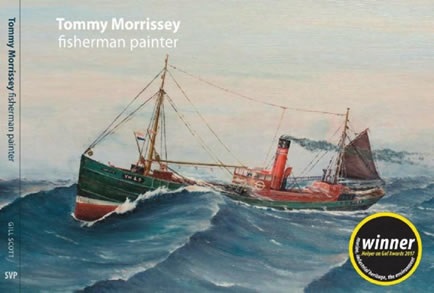 From 1970 onwards he became
involved in the folk revival increasing his repertoire of songs and singing in the Old Ship with his
mate Charlie Pitman. They gave loads of visitors happy memories of time spent in Padstow. Tommy and
Charlie were recorded by Veteran records and produced a cassette called "Pass Around the
Grog". The family often came home to find Strand Street full of film companies or University
students doing a thesis on May Day.
From 1970 onwards he became
involved in the folk revival increasing his repertoire of songs and singing in the Old Ship with his
mate Charlie Pitman. They gave loads of visitors happy memories of time spent in Padstow. Tommy and
Charlie were recorded by Veteran records and produced a cassette called "Pass Around the
Grog". The family often came home to find Strand Street full of film companies or University
students doing a thesis on May Day.
Throughout all this he was a fisherman first and foremost
and many of the young would be fishermen went to sea with Tommy to learn the ropes. He was a hard
taskmaster but you were taught to do the job properly with due respect for the power of the
sea.
Tommy a man who overcame illness loved to fish to paint to sing to entertain people and
led a very full life but first and foremost he was a Padstonian extremely proud of his town and his
home.
Sir Goldsworthy Gurney
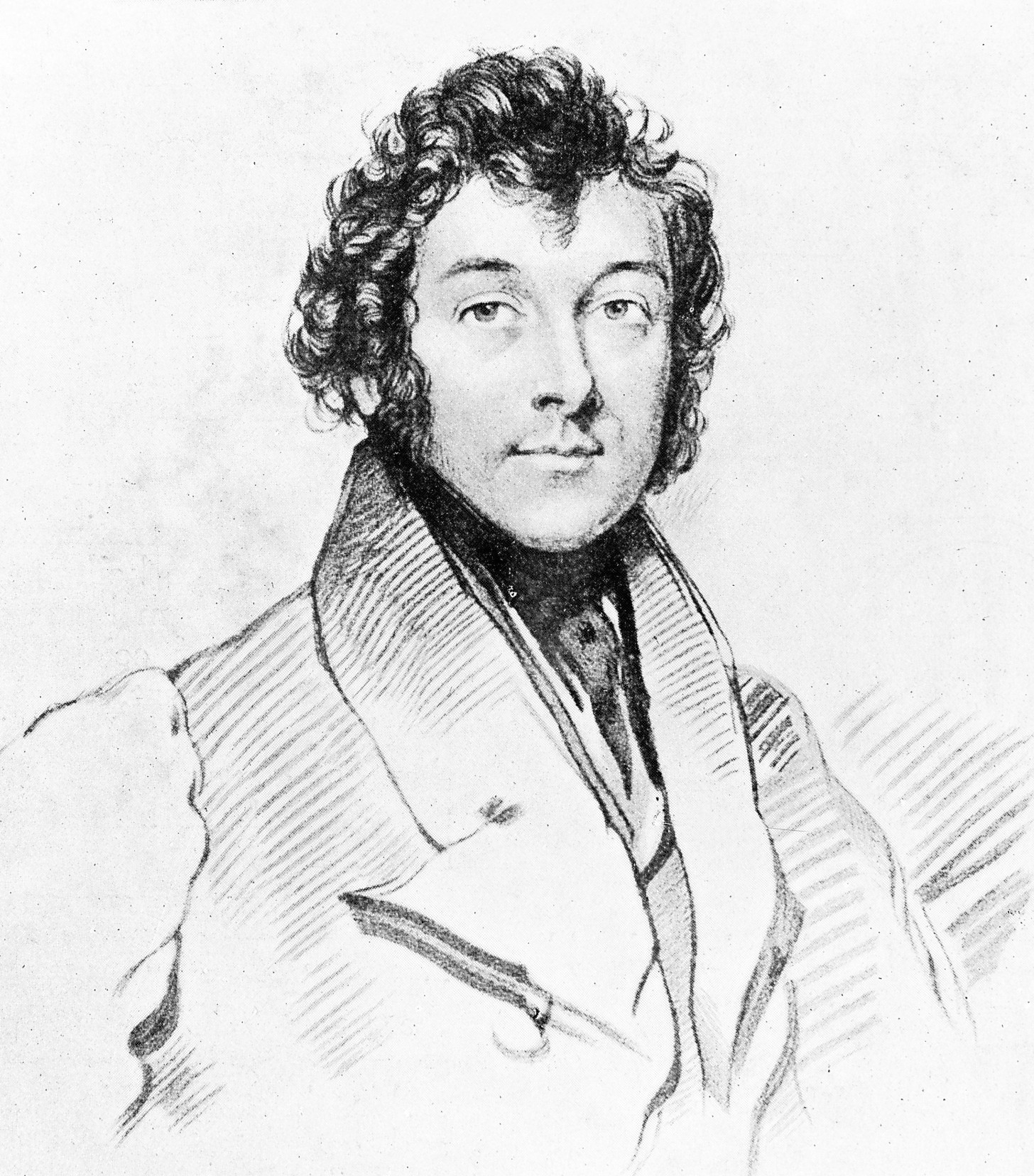 Goldsworthy Gurney was born at Treator near Padstow on 14 February 1793. His
unusual Christian name was his grandmother's surname but taken from his godmother who was a Maid
of Honour to Queen Charlotte. He attended Truro Grammar School and after leaving school studied
medicine with a Dr Avery at Wadebridge, later taking over the practice in 1813. He married a farmer’s
daughter, Elizabeth Symons, from Launcells (near Stratton, Bude) and settled in Wadebridge where he
practiced as a surgeon. At an early age he met fellow Cornishman, Richard Trevithick, a pioneer of
steam railways, and went on to build a steam-powered road vehicle which successfully travelled to and
from London to Bath at an average speed of 15 miles per hour. Gurney built several more carriages and
opened a passenger service.
Goldsworthy Gurney was born at Treator near Padstow on 14 February 1793. His
unusual Christian name was his grandmother's surname but taken from his godmother who was a Maid
of Honour to Queen Charlotte. He attended Truro Grammar School and after leaving school studied
medicine with a Dr Avery at Wadebridge, later taking over the practice in 1813. He married a farmer’s
daughter, Elizabeth Symons, from Launcells (near Stratton, Bude) and settled in Wadebridge where he
practiced as a surgeon. At an early age he met fellow Cornishman, Richard Trevithick, a pioneer of
steam railways, and went on to build a steam-powered road vehicle which successfully travelled to and
from London to Bath at an average speed of 15 miles per hour. Gurney built several more carriages and
opened a passenger service.
He moved with his family to London in 1820, apparently discontented with
rural life and wishing to seek his fortune. The family lived at 7 Argyle Street, near Hanover Square,
where Gurney continued his practice as a surgeon
In 1823 was awarded an Isis gold medal of the Royal Society of Arts for devising an oxy-hydrogen blowpipe (similar to a Bunsen burner).
In 1830, Gurney leased some land overlooking Summerleaze Beach at Bude and started construction of a new house to be built amongst the sand hills. The property rested on a concrete raft foundation, one of the earliest examples of this form.
Here, Gurney
developed the principle of illumination by the forcing of oxygen into a flame to increase the
brilliance of that flame. He called this bright light the Bude Light. Bude lights were fitted in the
House of Commons. It is claimed that he replaced 280 candles with 3 of his lamps and they lit the
House for 60 years until the arrival of electricity. This work was applied to lighthouse lamps, in the
choice of light source and the use of magnifying lenses to intensify the light. He introduced a system
of on-off patterns to enable those at sea to identify which lighthouse they could see by virtue of the
flashing.
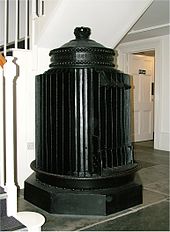 The Gurney Stove, an
invention which Gurney patented in 1856, was used extensively to heat a variety of buildings. Its most
interesting feature is the use of ribs to increase the external surface area of the stove, thereby
increasing the amount of heat transferred into the room.
The Gurney Stove, an
invention which Gurney patented in 1856, was used extensively to heat a variety of buildings. Its most
interesting feature is the use of ribs to increase the external surface area of the stove, thereby
increasing the amount of heat transferred into the room.
He was knighted by Queen Victoria in 1863, shortly before suffering a stroke.
He retired to his small house at Poughill (near Bude) with his daughter until his death on 28 February 1875. He is buried at Launcells parish church.
